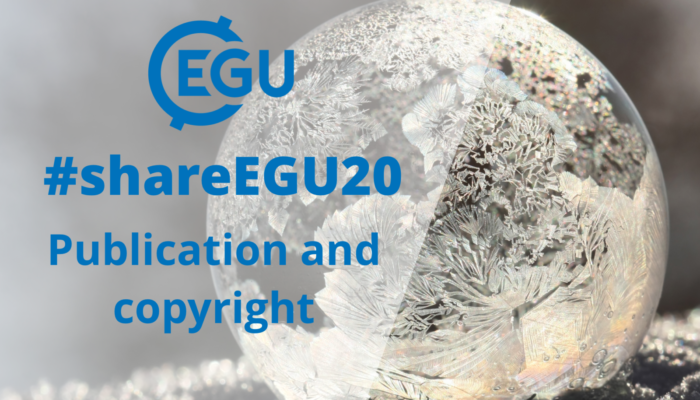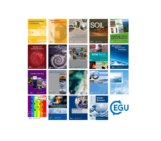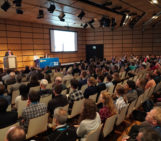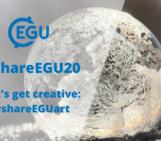
Several questions have come up recently about uploading materials to #shareEGU20 and what that means in terms of copyright protections and publication. So we have decided to address two of the biggest questions here:
Will sharing my content on #shareEGU20 affect my chance of publishing it later?
Short answer: No, it shouldn’t.
Long answer: it depends on where you plan on publishing, as some publishers do not embrace preprints. Because all abstracts (and therefore all materials uploaded to them in the form of a display, regardless of the upload format) have been given a DOI, they function as preprints. This fact, that displays function as preprints, is supported by the discussion element (comments) and the fact that all abstracts and displays are being hosted by EGUsphere, the EGU’s new open access online repository, in its interim format before being rolled out fully later on this year. Because the sharing of abstracts and displays follows a preprint style and not a conference paper style, most publishers do not consider this pre-emptive. For example, in Nature Research’s guidelines for publication, they explicitly state:
Posting of preprints is not considered prior publication and will not jeopardize consideration at Nature Research journals.
If you are concerned, you should know that you control what content you choose to upload, so it could be introductory data, a literature summary or a methodology rather than preliminary data that you are not ready to share yet. Additionally, you can decide to add a link in your materials to an external website, where you have more control over how long the content is available. One important benefit of uploading your materials to the DOI-linked abstract is that it provides proof of the primacy of your research in the face of any unscrupulous people attempting to copy it.
What about using other authors’ work/copyrighted material in my talk?
Copyrighted material that you were planning to use in your presentation during the physical meeting has the exact same restrictions on it for #shareEGU20. If you intend to reproduce work that is published elsewhere, you must obtain permission to do so. This is usually really straightforward, and if the author published the material(s) using open access or Creative Commons, it’s even easier to include it.
Here are some simple guidelines for what you need to know about reproducing work:
- Identify who holds the copyright: you, your institution or a third party.
- If someone other than you holds the copyright, determine whether you need to get permission. You can often find this out by checking the copyright holder (examples from Nature, Science, Elsevier, Springer and Wiley). If work is covered by a Creative Commons licence or is published open access, you can use the work without any additional permissions, as long as you correctly acknowledge the author/creator.
- If necessary, ask for permission to replicate an extract from the work. More often than not, especially for a conference presentation, this is free, but you will need to check with the author or publisher of the work in question.
- Keep a copy of the permission once you have it. Sometimes this takes the form of an email permission from an author; other times, it can be a publisher’s formal receipt.
- Acknowledge the permissions in the presentation, for example: “graph reproduced with permission from Copernicus.”
- Bask in how good your research looks in comparison with the rest of the body of literature!
Two important types of copyright:
Creative Commons Attribution 4.0 License
Creative commons copyright means you are free to:
 Share — copy and redistribute the material in any medium or format.
Share — copy and redistribute the material in any medium or format.
![]() Adapt — remix, transform, and build upon the material for any purpose, even commercially.
Adapt — remix, transform, and build upon the material for any purpose, even commercially.
As long as you give appropriate credit, provide a link to the licence, and indicate if changes were made, then you are free to use this material. You may do so in any reasonable manner, but not in any way that suggests the licenser endorses you or your use.
- The licence holder cannot revoke your use as long as you follow the licence terms.
- The CC BY License, of which 4.0 is the most recent version, was developed to facilitate open access – namely, free, immediate access to, and unrestricted reuse of, original works of all types.
- Under this licence, authors agree to make the contents legally available for reuse, without permission or fees, for virtually any purpose. Anyone may copy, distribute, or reuse these articles, as long as the author and original source are properly cited. Thus, CC BY facilitates the dissemination, transfer, and growth of scientific knowledge.
- The full legal code of this licence is available here.
Crown copyright or the Open Government licence.
An unusual version of creative commons copyright that you may encounter is Crown Copyright. This functions for in most cases as a variation of a Creative Commons licence, but has a different way of acknowledging the permissions. For works written by authors affiliated with the British Government and its institutions, authors may be asked to use the following statement, which has been approved by the Information Policy department of The National Archives:
“Contains public sector information licensed under the Open Government Licence v3.0.”
Due to the ongoing coronavirus outbreak, EGU has made the decision to cancel this year’s physical General Assembly in Vienna and instead offer a partial alternative meeting online, called #shareEGU20. Over the next few weeks in the run up to #shareEGU20, which will be held from the 4 – 8 May 2020, we will be posting regular updates and information about how to get involved, what EGU can offer during this week and how to find each other. We know that there will be many, many questions that people have, and we are learning how to do this right along with you, so please send us your questions over social media or by emailing egu2020@copernicus.org or communications@egu.eu. We’re looking forward to sharing EGU with you, online!




